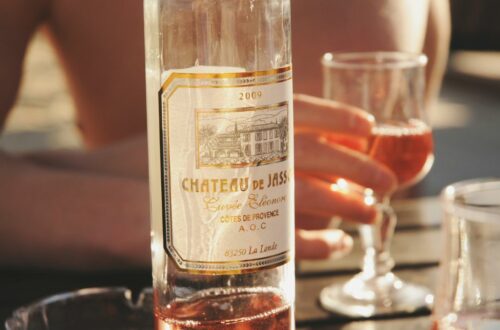
Mourvèdre In Provence
Ever wonder what gives Provençal wines that certain je ne sais quoi?
That bold structure, the hint of spice, the depth that lingers on the palate? Well, folks, there’s a secret weapon behind the scenes, and its name is Mourvèdre.
Today, we’re diving deep into this fascinating grape variety, exploring its history, its unique character, and why Provence is the perfect place for it to shine.
So, grab a glass (preferably filled with a Mourvèdre-dominant blend!), settle in, and let’s discover what Mourvèdre in Provence really means!
Mourvèdre produces wines that are spicy and structured. If you like Cabernet Sauvignon, then you should definitely give Mourvèdre a try!
Mourvèdre : The Jewel of Provence
Our story begins in sunny Spain, specifically Valencia. That’s where Mourvèdre (also known as Monastrell) first set its roots, basking in the warm Mediterranean climate.
Fast forward a few centuries, and Mourvèdre finds itself hitching a ride (thanks to enterprising traders) across the sea to Provence. It was like a homecoming for this sun-loving grape: the warm days, the cool nights, the limestone-rich soils – it was all a perfect match for Mourvèdre to thrive.
The limestone soils play a crucial role, providing excellent drainage and imparting a distinctive minerality to the wines.
The long, warm autumns provide extended periods of sunshine allowing Mourvèdre grapes to ripen slowly and evenly, developing those concentrated flavors and bold tannins we love.
There’s even a fascinating concept called “vine visibility to the sea.”
Imagine this: vineyards nestled on slopes overlooking the sparkling Mediterranean. This proximity to the sea provides a moderating effect, with cool evening breezes tempering the daytime heat.
This allows Mourvèdre to mature without losing its acidity – a key ingredient for long-aging potential.
Mourvèdre’s Profile and Maturation
So, what does a Mourvèdre grape look like? Think small and mighty.
These compact clusters hold tightly packed berries with thick skins, hinting at the concentrated flavors waiting to be unleashed.
On the eyes, you’ll get a wine with a a deep ruby hue – a true testament to the grape’s dark soul.
Take a sip, and you’ll be greeted by blackberry and plum aromas with earthy notes, often accompanied by intriguing hints of spice and even a touch of something like leather or stable (don’t worry, it’s a good thing!).
But here’s the kicker: Mourvèdre is a late bloomer. Those bold tannins and concentrated flavors need time to soften and develop their full complexity. Think of it like a shy person who needs to warm up to the party.
Give a Mourvèdre-based wine a few years in the bottle, and you’ll be rewarded with layers of tobacco, leather, and even hints of spice emerging.
Speaking of tannins and alcohol, Mourvèdre packs a punch. These wines are known for their robust structure and higher alcohol content.
But fear not, my friends! While they might seem intimidating at first, Mourvèdre’s tannins are surprisingly elegant, leaving a smooth and supple finish rather than an astringent bite.
It’s all about balance, people, and Mourvèdre has mastered it, playing beautifully between power and finesse.
Bandol: Mourvèdre’s Finest Expression
Now, let’s talk about Bandol.
This little corner of Provence is where Mourvèdre truly shines. With strict appellation regulations ensuring a minimum of 50% Mourvèdre in the blend, Bandol wines are the ultimate expression of this grape variety.
But what makes Bandol so special?
First off, there’s the geography.
Nestled between the Mediterranean Sea and the Sainte-Baume mountain range, Bandol experiences a unique microclimate. High night temperatures and humidity during grape ripening contribute to the richness and concentration of Mourvèdre grapes.
However, don’t forget the mighty Mistral wind, a powerful force that sweeps through the region. The strategic positioning of vineyards, often tucked away on slopes facing away from the Mistral, protects the delicate Mourvèdre vines from its harsh winds.
Bandol wines are known for their impressive aging potential. The combination of Mourvèdre’s robust tannins and the meticulous aging requirements (a minimum of 18 months, with at least 12 months in oak barrels) results in wines that evolve beautifully over time : the tannins become velvety.
A great expresssion of this velvety impression is the Cuvée Fontanéou from Bastide Blanche!
Now that you know all the secrets of Mourvèdre, let’s talk about enjoying it to the fullest!
These wines are perfect partners for bold flavors. Think grilled meats, hearty stews, or even rich vegetarian dishes with mushrooms or lentils. The high tannins can stand up to these robust flavors.
As for serving temperature, a slight chill can actually enhance Mourvèdre’s character. Aim for around 55-60°F (13-15°C) to allow the aromas to unfurl without overwhelming the palate with alcohol.
Decanting can also be beneficial for younger Mourvèdre wines, helping to soften the tannins and release the full spectrum of flavors.
Seeing as Mourvèdre is the Provence equivalent of Cabernet Sauvignon, if you want to know more about decanting wines (how and when), check out this post.
Conclusion : Mourvedre In Provence
So there you have it! Mourvèdre: the heart and soul of many delicious Provençal wines.
From its fascinating history to its unique characteristics and perfect pairing options, this grape variety offers a truly captivating wine experience.
Ready to embark on your own Mourvèdre adventure? Check out my favourite adresses to drink Bandol wines with a view!
Don’t forget to share your Mourvèdre experiences with us in the comments below! What are your favorite Mourvèdre-based wines?







